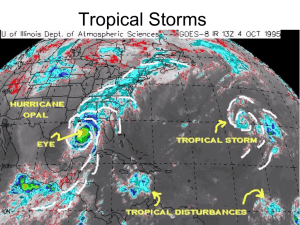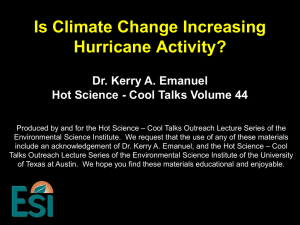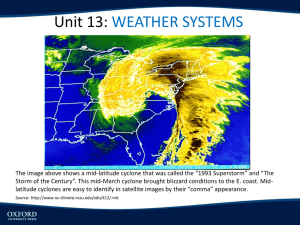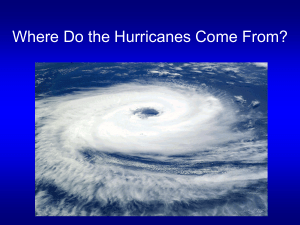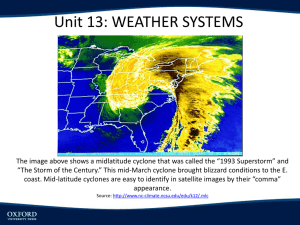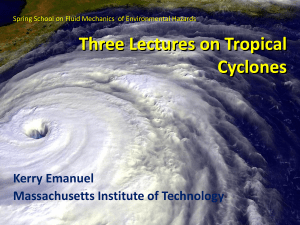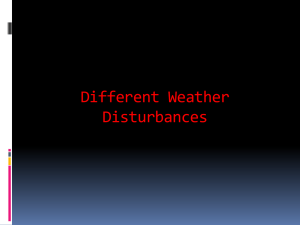PPT3
advertisement
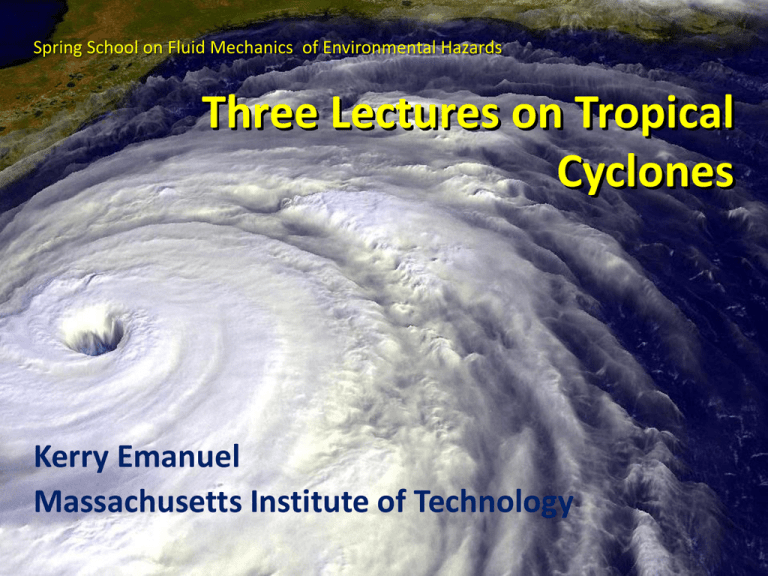
Spring School on Fluid Mechanics of Environmental Hazards Three Lectures on Tropical Cyclones Kerry Emanuel Massachusetts Institute of Technology Lecture 3: Using Physics to Assess Tropical Cyclone Risk in a Changing Climate Tropical Cyclones Do Respond to Climate Change! Atlantic Sea Surface Temperatures and Storm Max Power Dissipation Data Sources: NOAA/TPC, UKMO/HADSST1 Years included: 1870-2006 Scaled Temperature Power Dissipation Index (PDI) (Smoothed with a 1-3-4-3-1 filter) 10-year Running Average of Aug-Oct NH Surface T and MDR SST Tropical Atlantic SST(blue), Global Mean Surface Temperature (red), Aerosol Forcing (aqua) Global mean surface temperature Tropical Atlantic sea surface temperature Sulfate aerosol radiative forcing Mann, M. E., and K. A. Emanuel, 2006. Atlantic hurricane trends linked to climate change. EOS, 87, 233-244. Best Fit Linear Combination of Global Warming and Aerosol Forcing (red) versus Tropical Atlantic SST (blue) Tropical Atlantic sea surface temperature Global Surface T + Aerosol Forcing Mann, M. E., and K. A. Emanuel, 2006. Atlantic hurricane trends linked to climate change. EOS, 87, 233-244. Effect of Increased Potential Intensity on Hurricane Katrina Paleotempestology Paleotempestology barrier beach upland overwash fan backbarrier marsh a) lagoon barrier beach upland overwash fan b) backbarrier marsh lagoon terminal lobes flood tidal delta Source: Jeff Donnelly, WHOI Donnelly and Woodruff (2006) Photograph of stalagmite ATM7 showing depth of radiometric dating samples, micromilling track across approximately annually laminated couplets, and agedepth curve. Frappier et al., Geology, 2007 Frappier et al., Geology, 2007 Assessing Tropical Cyclone Risk: Historical Statistics Are Inadequate U.S. Hurricane Damage, 1900-2004,Adjusted for Inflation, Wealth, and Population Top 10 Northeast Storms Since 1851 Issues with Direct Use of Global Climate Models: • Today’s global models are too coarse to simulate high intensity events • Not practical to run models for long enough to generate high quality regional statistics • Embedding regional models is feasible but expensive Our Approach: • Step 1: Randomly seed ocean basins with weak (12 m/s) warm-core vortices • Step 2: Determine tracks of candidate storms using a simple model that moves storms with mean background wind • Step 3: Run a deterministic coupled tropical cyclone intensity model along each synthetic track, discarding all storms that fail to achieve winds of at least 17 m/s (random seeding method) • Step 4: Assess risk using statistics of surviving events Synthetic Track Generation, Using Synthetic Wind Time Series • Postulate that TCs move with vertically averaged environmental flow plus a “beta drift” correction (Beta and Advection Model, or “BAMS”) • Approximate “vertically averaged” by weighted mean of 850 and 250 hPa flow Synthetic wind time series • Monthly mean, variances and co-variances from NCEP re-analysis data • Synthetic time series constrained to have the correct mean, variance, co-variances and an power series 3 250 hPa zonal wind modeled as Fourier series in time with random phase: u250 ( x, y, , t ) u250 ( x, y, ) u ' ( x, y, ) F1 (t ) 2 250 F1 2 N n N n 3 n 1 3 2 sin 2 nt X 1n T n 1 where T is a time scale corresponding to the period of the lowest frequency wave in the series, N is the total number of waves retained, and X 1n is, for each n, a random number between 0 and 1. The time series of other flow components: v250 ( x, y, , t ) v250 ( x, y, ) A21F1 (t ) A22 F2 (t ), u850 ( x, y, , t ) u850 ( x, y, ) A31F1 (t ) A32 F2 (t ) A33 F3 (t ), v850 ( x, y, , t ) v850 ( x, y, ) A41F1 (t ) A42 F2 (t ) A43 F3 (t ) A44 F4 (t ), or V = V AF where each Fi has a different random phase, and A satisfies T A A = COV where COV is the symmetric matrix containing the variances and covariances of the flow components. Example: u250 30 ms 1 N 15 u '2250 ( x, y, ) 10 ms 1 T 15 days Track: Vtrack V850 1 V250 V , Empirically determined constants: 0.8, 1 u 0 ms , v 2.5 ms 1 Tropical Cyclone Intensity • Run coupled deterministic model (CHIPS, Emanuel et al., 2004) along each track • Use monthly mean potential intensity, ocean mixed layer depth, and sub-mixed layer thermal stratification • Use shear from synthetic wind time series • Initial intensity specified as 12 ms1 1 • Tracks terminated when v < 17 ms 6-hour zonal displacements in region bounded by 10o and 30o N latitude, and 80o and 30o W longitude, using only post-1970 hurricane data Example: 50 Synthetic Tracks 200 Random Western North Pacific Events Cumulative Distribution of Storm Lifetime Peak Wind Speed, with Sample of 2946 Synthetic Tracks Return Periods Random Seeding Method: Calibration • Absolute genesis frequency calibrated to North Atlantic during the period 1980-2005 Genesis rates Western North Pacific Southern Hemisphere Eastern North Pacific Atlantic Calibrated to Atlantic North Indian Ocean Seasonal Cycles Western North Pacific Captures effects of regional climate phenomena (e.g. ENSO, AMM) Year by Year Comparison with Best Track and with Knutson et al., 2007 Simulated vs. Observed Power Dissipation Trends, 1980-2006 Global Percentage of Cat 4 & Cat 5 Storms Now Use Daily Output from IPCC Models to Derive Wind Statistics, Thermodynamic State Needed by Synthetic Track Technique Compare two simulations each from 7 IPCC models: 1. Last 20 years of 20th century simulations 2. Years 2180-2200 of IPCC Scenario A1b (CO2 stabilized at 720 ppm) Basin-Wide Percentage Change in Power Dissipation Different Climate Models Basin-Wide Percentage Change in Storm Frequency Different Climate Models 7 Model Consensus Change in Storm Frequency Reds: Increases Blues: Decreases Feedback of Global Tropical Cyclone Activity on the Climate System Strong Mixing of Upper Ocean Direct mixing by tropical cyclones Emanuel (2001) estimated global rate of heat input as 1.4 X 1015 Watts Source: Rob Korty, CalTech TC Mixing May Induce Much or Most of the Observed Poleward Heat Flux by the Oceans 90 S EQ Trenberth and Caron, 2001 90 N TC-Mixing may be Crucial for High-Latitude Warmth and Low-Latitude Moderation During Warm Climates, such as that of the Eocene


